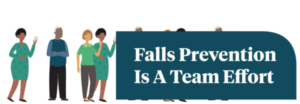Sep 14
Increasing Awareness about Falls Prevention Strategies

According to the National Council on Aging, falls are the leading cause of fatal and nonfatal injuries for older Americans each year. Falls impact older adults’ safety and independence but they do not have to be an inevitable part of aging. Falls, with or without injury can impact quality of life. A fear of falling may lead older adults to limit their activities and social engagements which can result in further physical decline, depression, social isolation, and feelings of helplessness.
The National Institute on Aging shares that many things can cause falls: “Your eyesight, hearing, and reflexes might not be as sharp as they were when you were younger. Diabetes, heart disease, or problems with your thyroid, nerves, feet, or blood vessels can affect your balance. Some medicines can cause you to feel dizzy or sleepy, making you more likely to fall. Other causes include safety hazards in the home or community environment.” If you take care of your overall health, you may reduce the likelihood of falling. Some tips each of us can follow to prevent falls are:
- Talk with your health care provider about medication side effects.
- Make your home safer by using night lights, installing grab bars in the bathroom, and securing carpet to the floors.
- Stand up slowly to avoid dizziness.
- Do strength and balance exercises.
- Get your vision and hearing checked regularly.
- Use a cane or walker if you need more stability.
The National Institute on Aging provides more details on these topics as well as a handy infographic of the information here. The National Council on Aging also provides excellent falls prevention tips here.
Since strength and balance help to prevent falls, we checked in with Brad Bishop, owner of Synergy Personal Fitness Training in Waltham to ask about ideas to help older adults in our communities. “Each of us can do a lot to prevent falls by keeping our body strong,” shares Bishop. “Keep moving your body any way that you can. Walking is great exercise. Each person can go at their own pace for whatever distance works for them and an assistive device such as a cane or walker can be used, if needed. There are exercises that can be done in a chair or standing holding onto a chair that help strengthen muscles and improve balance. If an individual must spend a lot of time in bed, there are even effective exercises that can be done lying down in bed. Bishop also notes that when you are standing, such as when waiting in line or selecting groceries from the shelf, a wider stance provides more stability and can help prevent a fall.
Here are a couple of sample exercises from Hopkins Medicine that help with balance and strength: https://www.hopkinsmedicine.org/health/wellness-and-prevention/fall-prevention-exercises. Local Councils on Aging offer many types of exercise programs, both virtual and in person. These exercise programs are a great way to improve your strength and balance. To find a link to your local Council on Aging, please visit our webpage that lists them by town here.
As we observe Falls Prevention Week from September 18-24 this year, let’s all work to stay safe from the risks of falls.


